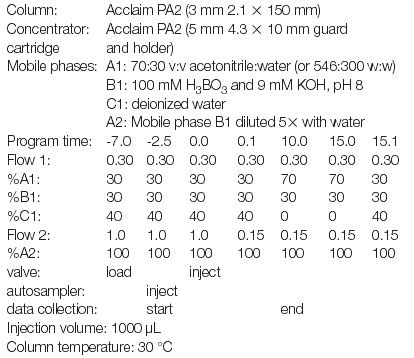Analysis of PFOA and PFOS in Water Using Reversed-Phase HPLC with Suppressed Conductivity Detection
LCGC Asia Pacific
Brian De Borba and Jeffrey S. Rohrer, Dionex Corporation
Suppressed conductivity detection is a well-developed method for detecting charged species. Reversed-phase high-performance liquid chromatography (RP-HPLC) is a well developed method of separating substances on the basis of hydrophobicity. There are some situations where it is advantageous to use these two methods together. Perfluoro-acids (PFOAs) are one class of compounds that are ionic, hydrophobic and have low UV absorbance and are, therefore, suited to this combination.
PFOA and perfluorooctanesulphonic acid (PFOS) are medium-chain perfluorinated acids with an assortment of industrial and consumer uses. They have been implicated in various health issues and are widely distributed and persistent in the environment. In this application, PFOA and PFOS in drinking water are concentrated by a column switching valve onto a cartridge, separated by RP-HPLC on an Acclaim PA2 column and detected by suppressed conductivity.
Conditions
HPLC system: Dionex ICS-3000 configured with DP dual gradient pump; DC detector/chromatography module equipped with conductivity detector and 6-port switching valve; ASI-100 autosampler equipped with 1000 µL syringe and loop. Pump 1 connects to port 3 on the switching valve and it provides the elution gradient. Pump 2 connects to the autosampler and loads the sample onto the concentrator and washes it. The autosampler outlet connects to port 6 of the valve. The concentrator is connected to ports 1 and 4, replacing the sample loop. The analytical column connects to port 2. Port 5 goes to waste through a restrictor capillary. When the valve is in the load position, the sample is injected onto the concentrator, which is washed by pump 2 to remove matrix interferences. It is switched to the inject position for elution by pump 1.

Suppressor: Dionex ASRS ULTRA II 2 mm, with external regenerant
Pump for regenerant: MasterFlex C/L peristaltic pump, model 77120-32, with 0.89 mm i.d. tubing.
Regenerant: 25 meq/L H2SO4 at approx 0.5 mL/min
Results and Discussion
We selected a borate buffer at pH 8 because of its low background conductivity. The separation was performed on an Acclaim PA2 column because it provides excellent resistance to alkaline conditions and better loadability compared to standard RP columns (C18). Since the detection limit by conductivity is around 0.5 ng, to achieve low detection limits, we used a preconcentration technique, as described above.
Because fluorocarbon polymers are frequently used in HPLC instruments, they present two difficulties for analysing fluorinated organics: carry-over and sample adsorption. We selected the Summit ASI-100 autosampler to greatly minimize these problems because its sample-wetted surfaces are PEEK and stainless steel.
Figure 1 shows typical chromatography for the analysis of a tap water sample. Spike recoveries between 2 and 200 µg/L were 98–101% for PFOA and 97–137% for PFOS. Similar results were obtained for bottled water and a synthetic water matrix.

Figure 1
Conclusion
We report a detection limit of 0.5 µg/L using an RP HPLC/suppressed conductivity detection method for analysing PFOS and PFOA. This technique can be applied to other fluorinated organic acids (C6–C18 homologs) as well as a variety of surface active sulphates and sulphonates (e.g., SDS, LAS, etc.).
Brian De Borba and Jeffrey S. Rohrer, Dionex Corporation, Sunnyvale, California, USA.

Dionex Corporation
1228 Titan Way, P.O. Box 3603, Sunnyvale, California 94088-3603, USA
tel. +1 408 737 0700 fax +1 408 730 9403 Website: www.dionex.com

Analytical Challenges in Measuring Migration from Food Contact Materials
November 2nd 2015Food contact materials contain low molecular weight additives and processing aids which can migrate into foods leading to trace levels of contamination. Food safety is ensured through regulations, comprising compositional controls and migration limits, which present a significant analytical challenge to the food industry to ensure compliance and demonstrate due diligence. Of the various analytical approaches, LC-MS/MS has proved to be an essential tool in monitoring migration of target compounds into foods, and more sophisticated approaches such as LC-high resolution MS (Orbitrap) are being increasingly used for untargeted analysis to monitor non-intentionally added substances. This podcast will provide an overview to this area, illustrated with various applications showing current approaches being employed.













